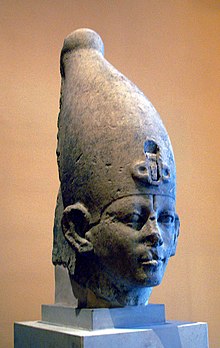Sekhemre Khutawy Sobekhotep
| Sekhemre Khutawy Sobekhotep | |
|---|---|
| Sobekhotep I or Sobekhotep II | |

Head of a statue, thought to represent Sekhemre Khutawy Sobekhotep, although other attributions have been proposed
|
|
| Pharaoh | |
| Reign | At least three years, 1803–1800 BC or 1724–1718 BC(13th Dynasty) |
| Predecessor | Uncertain, Sobekneferu or Sedjefakare Kay Amenemhat VII |
| Successor | Uncertain, Sekhemkare Sonbef or Khendjer |
| Father | Uncertain, possibly Amenemhat IV |
| Born | after 1900 BC |
| Died | before 1700 BC |
Sekhemre Khutawy Sobekhotep (appears in most sources as Amenemhat Sobekhotep; now believed to be Sobekhotep I; known as Sobekhotep II in older studies) was an Egyptian pharaoh of the 13th Dynasty during the Second Intermediate Period, who reigned for at least three years c. 1800 BC. His chronological position is much debated, Sekhemre Khutawy Sobekhotep being either the founder of the dynasty, in which case he is called Sobekhotep I, or its twentieth ruler, in which case he is called Sobekhotep II. In his 1997 study of the Second Intermediate Period, the Egyptologist Kim Ryholt makes a strong case for Sekhemre Khutawy Sobekhotep as the founder of the dynasty, a hypothesis that is now dominant in Egyptology. His tomb was believed to have been discovered in Abydos in 2013, but its attribution is now questioned.
Sekhemre Khutawy Sobekhotep is well attested by contemporary sources. First, he is mentioned on the Kahun Papyrus IV, now in the Petrie Museum (UC32166). (Ryholt, p. 315) This Kahun Papyrus is "a census of the household of a lector-priest that is dated to the first regnal year" of the king and also records the birth of a son of the lector-priest during a 40th regnal year, "which can only refer to Amenemhat III." This establishes that Sekhemre Khutawy Sobekhotep reigned close in time to Amenemhat III. Second, a number of architectural elements bearing Sobekhotep's titulary are known: a fragment of a Hebsed chapel from Medamud, three lintels from Deir el-Bahri and Medamud, an architrave from Luxor and a doorjamb from Medamud that is now in the Louvre. Three Nile level records from Semna and Kumna in Nubia are also attributable to Sekhemre Khutawy Sobekhotep, the latest of which is dated to year 4, showing that he reigned for at least three complete years. Smaller artifacts mentioning Sekhemre Khutawy Sobekhotep comprise a cylinder seal from Gebelein, an adze-blade, a statuette from Kerma and a faience bead, now in the Petrie Museum (UC 13202).
...
Wikipedia
